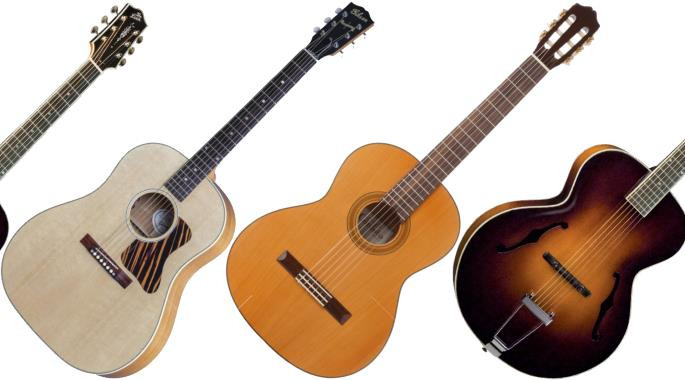 Acoustic Guitars
Acoustic Guitars
The acoustic guitar stands as a cornerstone of music, beloved worldwide for its versatility and expressive sound. If you’re venturing into the world of acoustic guitars, you’ll quickly discover a vast landscape of options. From different body shapes to varying string types, the choices can feel overwhelming. This guide will clearly break down the main types of acoustic guitars, helping you navigate the selection process and find the perfect instrument to match your musical aspirations.
Understanding the Acoustic Guitar
Before we delve into the specifics of Acoustic Guitar Types, let’s define what an acoustic guitar is. At its core, an acoustic guitar is a stringed instrument that produces sound through the vibration of its strings, amplified by a hollow body. Played by strumming or fingerpicking, the strings’ resonance interacts with the guitar’s body, creating the rich and dynamic tones we associate with acoustic music. This natural, unamplified sound remains a vital element in countless musical genres, both in recordings and live performances.
Acoustic Guitar Types: A Detailed Overview
Over time, the fundamental design of the acoustic guitar has evolved, leading to a diverse range of styles. Today, players can choose from various string materials, body shapes, sizes, and tonewoods, each contributing to the instrument’s unique sonic character.
This guide focuses on the three most common acoustic guitar types, along with their popular variations and the musical styles they often suit best. We’ll also touch on the significance of different woods in shaping the guitar’s sound, an important factor when comparing models within the same category.
Let’s explore the primary categories of acoustic guitars:
1. Steel-String Acoustic Guitars
Gibson J-35 Slope Shoulder Dreadnought Guitar
Steel-string acoustic guitars are arguably the most popular and widely recognized type. Their versatility makes them a favorite across numerous musical genres. Equally adept at strumming chords and intricate fingerpicking, steel-strings are a workhorse for songwriters, performers, and recording artists. Within this broad category, you’ll find many sub-types, with dreadnought models being particularly prevalent. Essentially, any acoustic guitar that utilizes steel strings and relies on its hollow body for sound projection falls under the steel-string acoustic umbrella.
To simplify things, we’ll concentrate on the three primary body styles you’re most likely to encounter: Dreadnought, OM (Orchestra Model), and Parlor. These represent the most common and influential shapes in the steel-string world.
A general principle to remember is that smaller-bodied guitars tend to produce a warmer sound with a focused midrange. Conversely, larger bodies typically deliver greater volume and a more pronounced bass response. When comparing guitars of similar size, the choice of tonewoods becomes a more critical factor in discerning tonal differences.
Acoustic Guitar Size Comparison Chart
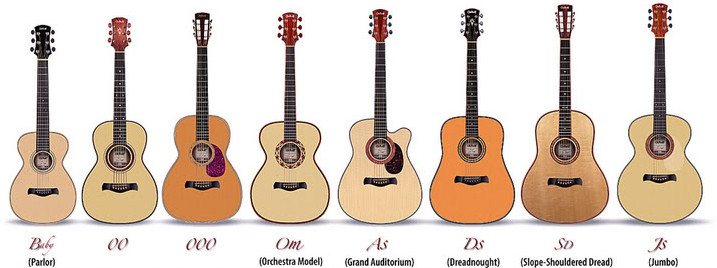 Acoustic Guitar Size Comparison Chart
Acoustic Guitar Size Comparison Chart
Dreadnought Guitars
Martin D-45 Square Shoulder Dreadnought Acoustic Guitar
The dreadnought is the quintessential acoustic guitar body shape, instantly recognizable and deeply ingrained in the collective image of an acoustic guitar. Originating from C.F. Martin & Co. in 1916, the dreadnought gained widespread popularity in the 1930s, a period when sound amplification was still in its early stages. Its powerful volume and rich tone made it ideal for ensemble playing. Today, its strong projection and deep low-end continue to make it a top choice for musicians.
The market is saturated with dreadnought guitars across various brands and price points, making them accessible to players of all levels and budgets.
Dreadnought guitars mainly come in two variations: square shoulder and slope shoulder. The square shoulder dreadnought features straighter lines in the upper and lower sections of the body, while the slope shoulder version has more rounded curves in these areas.
The dreadnought design has served as a blueprint for many contemporary acoustic body shapes, including grand auditorium, grand concert, and jumbo guitars, among others.
For improved access to the higher frets, cutaway versions are available for dreadnoughts and other body styles. Cutaways have become a standard feature, particularly on acoustic-electric guitars. While some players find the cutaway aesthetically less appealing, a common point in the acoustic vs acoustic-electric guitar debate, there’s no definitive acoustic sound quality advantage between cutaway and non-cutaway dreadnoughts.
OM (Orchestra Model) Guitars
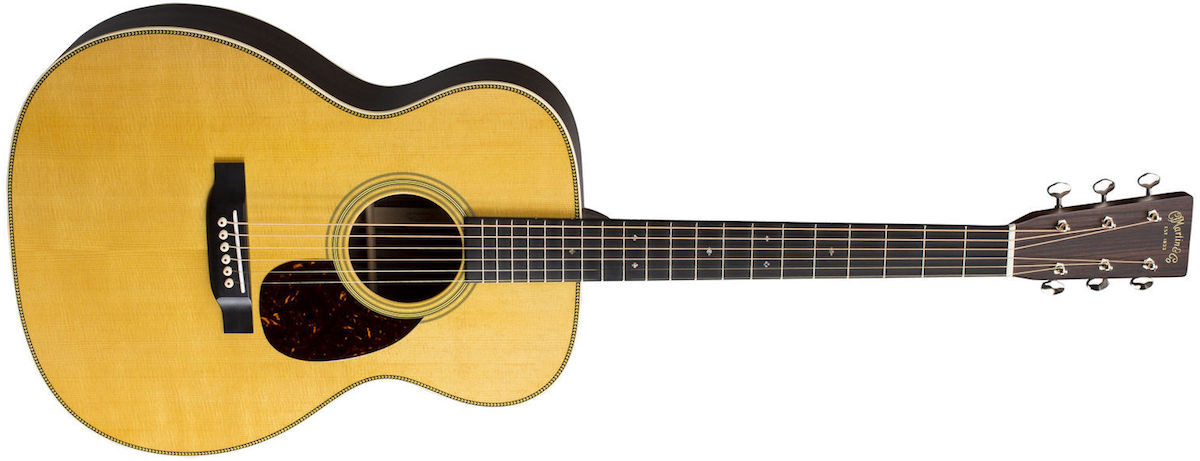 Martin OM-28
Martin OM-28
The OM, or Orchestra Model, body style represents a balanced middle ground between the larger dreadnought and the smaller parlor guitar. It performs admirably in both strumming and fingerpicking scenarios, though it might not be considered the absolute best for either technique individually. However, a well-crafted OM, such as the renowned Martin OM-28, remains a high-quality instrument that sounds exceptional across playing styles. Many players appreciate the OM’s clarity and defined notes. It’s often cited as one of the best acoustic guitar styles for fingerstyle guitar and a particularly good fit for singer-songwriters.
Key characteristics of the OM body include slightly elongated upper and lower bouts and a more defined waist. Many guitar manufacturers offer OM-style guitars, often incorporating their own specifications and naming conventions.
Parlor Guitars
Takamine GY11ME Parlor Guitar
Parlor guitars, characterized by their compact bodies, deliver a focused tone emphasizing the high-end and midrange frequencies. Their smaller size contributes to a somewhat boxier and more direct sound, especially when played forcefully. This distinct tonal quality makes parlor guitars well-suited for genres like blues, folk, and rock. They are also favored for fingerstyle playing because their smaller dimensions make it easier to “activate the top”—meaning to generate enough vibration in the guitar’s top to produce a full, resonant sound. A lighter touch may result in a weaker tone; a more deliberate playing style is needed to bring out the full spectrum of bass, mid, and treble frequencies.
It’s worth noting that there are no universally agreed-upon specifications for parlor guitars. This category encompasses a range of traditional and modern shapes, including 0, 00, and sometimes even 000 body styles, all known for their smaller size and similar sonic responsiveness. Some parlor guitars feature unique setups, from neck profiles to string action, further contributing to their individual character.
For deeper insights into these smaller guitar types, resources like Parlor.Guitars offer valuable information.
2. Nylon-String Guitars
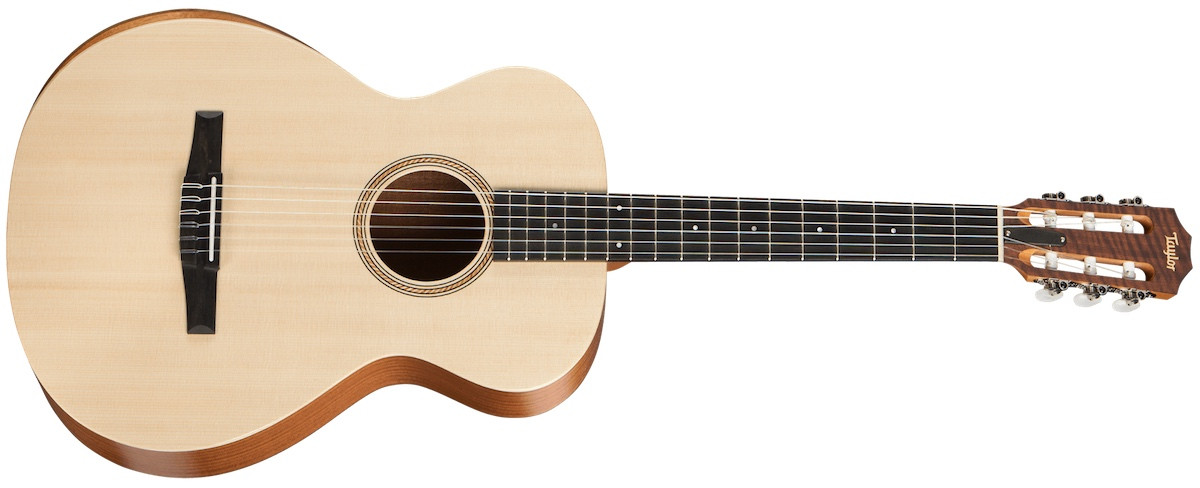 Taylor Academy 12e-N
Taylor Academy 12e-N
Nylon-string guitars are often considered the most beginner-friendly among the three main acoustic types. The soft texture of nylon strings makes them gentler on the fingertips, an advantage for beginners and younger players. They are also the standard choice for serious classical guitar students. Compared to steel-string guitars, nylon-string guitars produce a significantly warmer and mellower sound. While they lack the bright, ringing sustain of steel strings, they offer a smooth, non-harsh tone, especially in the higher registers.
Nylon strings also have lower tension than steel strings, facilitating complex classical and flamenco techniques.
Classical guitars and flamenco guitars are the two primary subcategories within nylon-string instruments. A hybrid category also exists, encompassing non-traditional designs like travel guitars, 3/4 size guitars, and silent guitars.
Let’s examine these subcategories in more detail:
Classical Guitars
Cordoba C3M Classical Guitar
Classical guitars are nylon-string instruments primarily designed for playing classical music. They are known for their clear, piano-like tone with ample volume. Maintaining a strong connection to traditional design, classical guitars blend historical elements with modern manufacturing techniques and materials.
Generally smaller than dreadnought guitars but slightly wider than standard parlor guitars, classical guitars are well-suited for players with smaller frames. Their size is closer to an OM guitar, but their body shape differs. Classical guitars typically have a slightly higher string action to accommodate various classical playing techniques. The nut width is also wider, usually by 0.2 to 0.3 inches compared to steel-string acoustics. This wider neck requires a greater finger stretch for wide chords and complex passages.
Flamenco Guitars
 Yamaha CG172SF Flamenco
Yamaha CG172SF Flamenco
Flamenco guitars are specifically crafted for flamenco music. A key feature is the inclusion of tap plates (also known as golpeadors) on the body, protecting the guitar from the percussive tapping integral to flamenco rhythms. Flamenco guitars typically have a lower string action, optimized for rapid playing and percussive strumming. This lower action also contributes to the characteristic “growly” and passionate tone associated with flamenco music when played with intensity.
Similar to classical guitars, flamenco guitars usually have a wider nut width than standard steel-string acoustic guitars.
Hybrid/Crossover and Other Nylon-String Guitars
Ibanez TOD10N Nylon String Guitar
Beyond classical and flamenco guitars, a range of non-traditional nylon-string options exist, blending elements from different guitar types. These “hybrid” or “crossover” guitars allow players to enjoy nylon strings without adhering to traditional body and neck specifications. Tim Henson’s signature acoustic-electric nylon-string guitar, used in his progressive metal band Polyphia, exemplifies this modern approach. Other examples include mini and 3/4 size nylon-string guitars designed for beginners.
The diversity of hybrid and crossover nylon-string guitars across guitar brands makes it challenging to define precise specifications. However, the general principles of body size and tone still apply: larger bodies tend to be louder with more bass, while smaller, thinner bodies emphasize midrange and treble frequencies.
3. Archtop Acoustic Guitars
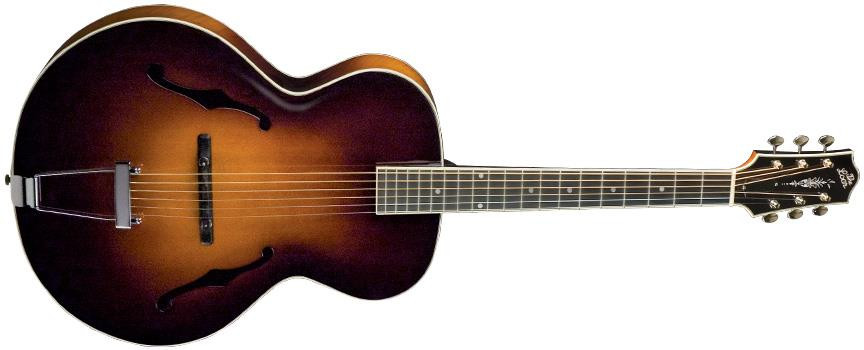 The Loar LH-700
The Loar LH-700
Archtop acoustic guitars are distinguished by their warm, punchy tone and relatively short sustain. This reduced sustain makes them well-suited for complex jazz passages and intricate chord voicings. Archtop guitars excel at “comping,” a rhythmic accompaniment style prevalent in jazz. Comping involves sophisticated muting, strumming, and fingerstyle techniques to create rhythmic and harmonic support.
While their unique sound makes them a valuable asset for jazz musicians, archtops are somewhat specialized instruments. If your primary musical interests lie outside of jazz (or possibly fingerstyle blues), a flat-top acoustic guitar might be a more versatile choice. However, for jazz enthusiasts, archtop acoustic guitars can significantly enhance their sonic palette.
Archtop guitars typically feature bulkier bodies, which can be less portable and comfortable compared to sleeker, modern acoustic designs.
4. Exploring Other Acoustic Guitar Types
Cigano GJ-15 Gypsy Jazz Guitar
Beyond the mainstream categories, several noteworthy acoustic guitar types deserve recognition. The Gypsy jazz guitar is a specialized acoustic guitar dedicated to the distinctive sound of Gypsy jazz music. Inspired by the instrument used by Django Reinhardt, it features a larger body than average and a longer neck. Visually, it stands out with its characteristic D-shaped soundhole, although some models sport a smaller oval soundhole. Gypsy guitars share tonal similarities with archtops but offer a more percussive and “snappy” sound. While most Gypsy guitars are steel-string, some nylon-string models exist, making categorization somewhat nuanced.
The 12-string acoustic guitar is another distinct type, a steel-string guitar with, as the name suggests, 12 strings. The doubled strings create a richer, fuller sound but can make techniques like string bending and sliding more challenging.
3/4 size acoustic guitars are commonly encountered by beginners and younger players. These smaller-scale guitars are designed for easier playability. Some manufacturers have created their own small guitar categories, such as “Mini” and “Junior,” which often fall under the broader parlor guitar category.
 Gold Tone PBR-D Resonator Guitar
Gold Tone PBR-D Resonator Guitar
The Resonator guitar, also known as a resophonic guitar, utilizes a metal resonator cone instead of a traditional wooden soundboard. This construction produces a bright, metallic, and thumpy tone, particularly well-suited for slide guitar playing and genres like bluegrass, blues, and country.
Traveler guitars and silent guitars round out this exploration of diverse acoustic types. These guitars prioritize portability while aiming to replicate the tone and playing feel of a standard acoustic. Many traveler guitars feature minimalist, skeletal bodies, resembling electric guitars in their construction. Some require amplification via an amp, PA mixer, or headphones, but they are designed to play and sound like acoustic instruments.
5. Sound Examples
Listen to these sound clips to hear the distinct tonal characteristics of different acoustic guitar types:
Sander Briones · Dreadnought – Sound Clip
Sander Briones · OM (Orchestra Model) – Sound Clip
Sander Briones · Parlor Guitar – Sound Clip
Sander Briones · Nylon String Guitar – Sound Clip
Sander Briones · Jumbo Acoustic – Sound Clip
6. Acoustic Guitar vs. Classical Guitar: Key Differences
A frequently asked question, especially among beginners, concerns the distinction between acoustic and classical guitars. In short, the primary differences lie in their strings, sound, nut width, scale length, and playing feel.
However, the terminology can sometimes be confusing. It’s more accurate to discuss the difference between steel-string and nylon-string guitars.
Acoustic steel-string guitars offer greater versatility for playing diverse musical styles. Nylon-string guitars are best suited for classical, Latin, flamenco, and certain pop music genres.
Nut Width and Scale Length Explained
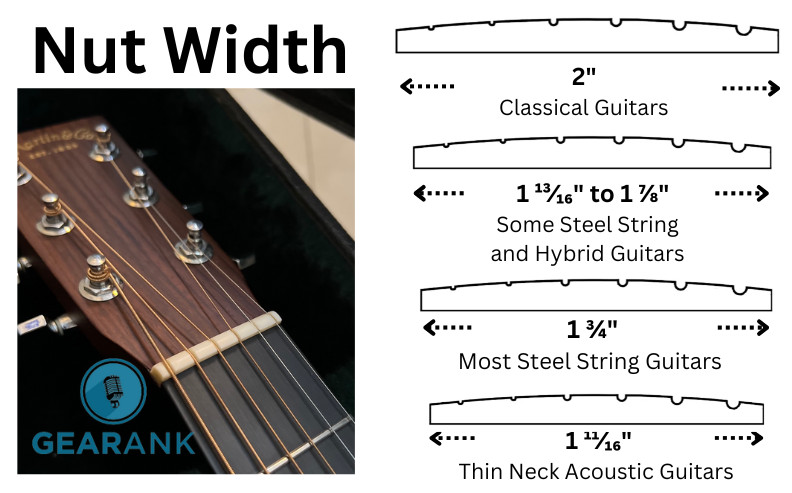 Nut Width
Nut Width
Nut width refers to the width of the guitar’s nut, the component located just before the first fret. Nut width is a good indicator of neck width. Narrower necks can be easier for some players but may feel cramped. Wider necks provide more space for fretting but can be challenging for those with smaller hands. Classical guitars typically have the widest necks, around 2 inches, while steel-string guitars range from approximately 1 ¹¹⁄₁₆” to 1 ⅞”.
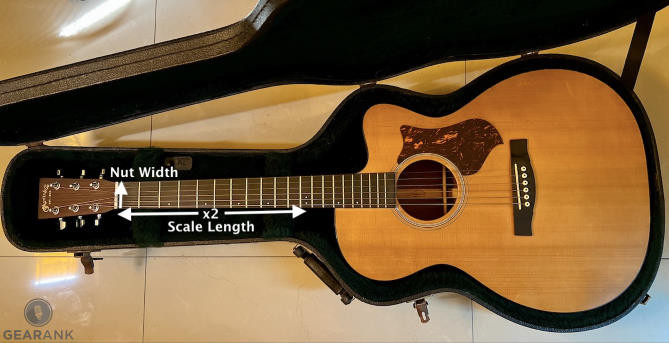 Scale Length
Scale Length
Scale length is the vibrating length of the strings between the nut and the bridge. Longer scale lengths result in higher string tension, creating a stiffer feel and potentially enhanced resonance. Shorter scale lengths have lower string tension, making them easier to play, and influencing the overall tone. Most acoustic guitars have a scale length ranging from 24.75″ to 25.6″.
7. Understanding Guitar Tonewoods
The choice of tonewoods significantly influences an acoustic guitar’s sound. Here’s an overview of common tonewoods and their general sonic characteristics. Keep in mind that tonewood selection is a complex topic with varying opinions, and construction methods also play a crucial role.
Remember that most guitars utilize at least two different tonewoods, so the final tone results from a combination of these materials.
Common Tonewoods and Their Characteristics:
- Sitka Spruce: The most prevalent top wood for acoustic guitars, Sitka spruce offers a wide dynamic range and excellent responsiveness. Its bright sound makes it suitable for both strumming and lead playing.
- Engelmann Spruce: Similar to Sitka but often more responsive to softer playing. However, it may not handle hard playing as well as Sitka. Ideal for fingerstyle guitarists.
- Adirondack Spruce: A highly prized tonewood, especially in vintage acoustics. Known for its lively and powerful sound, though some believe it requires more time to “open up” tonally compared to other spruces.
- Cedar: A warm and mellow tonewood favored for its rich tone. Less attack than spruce, making it a common choice for fingerstyle guitars and classical guitars.
- Mahogany: Typically used for backs and sides, mahogany provides a balanced representation of bass and midrange frequencies. Projects well but can sound darker compared to rosewood. Excellent for rhythm-focused playing but less ideal for lead or fingerpicking. All-mahogany guitars have gained popularity, highlighting mahogany’s tonal qualities. Budget-friendly alternatives include sapele and nyatoh. Learn more in our Acoustic Guitar Buyer’s Guide.
- Maple: Often used in archtops and jumbo guitars. Known for its bright, clear tone and quick decay, which helps control the often-boomy low-end of jumbo guitars.
- Rosewood: A popular choice for backs and sides due to its focused tone with a strong representation across the frequency spectrum (bass, mids, and treble). More focused than mahogany with good sustain, making it versatile for both fingerpicking and flatpicking. Generally more expensive than mahogany.
How Much Do Tonewoods Really Matter?
The sonic differences between tonewoods can be subtle, and guitar construction is arguably equally important. The Leonardo Guitar Research Project conducted studies comparing various tonewoods.
 YouTube video
YouTube video
In their research, as demonstrated by Gaëlle Solal playing guitars with 16 different tonewood combinations, they found that distinguishing between back and side woods was challenging. Less expensive, non-tropical woods performed comparably and produced similar sound qualities.
8. Laminate vs. Solid Wood Guitar Construction
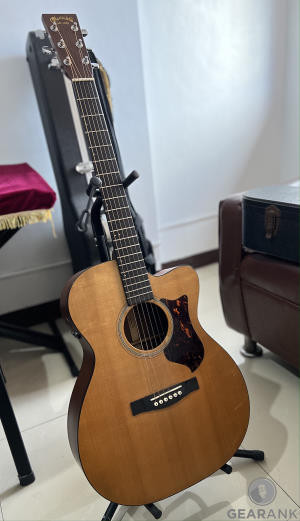 All-solid wood acoustic
All-solid wood acoustic
Laminate wood consists of thin layers of wood glued and pressed together, while solid wood is a single piece cut from a tree. Solid wood generally resonates more freely than laminate due to its natural structure.
This difference in resonance results in a fuller, richer tone from solid wood instruments compared to laminate guitars. However, laminate wood is more cost-effective, making it common in budget-friendly acoustic guitars.
You’ll often find distinctions between laminate guitars, solid-top guitars (solid wood top with laminate back and sides), and all-solid wood guitars. The more solid wood used, the more resonant the guitar body tends to be. The top wood is the most critical factor in an acoustic guitar’s sound, while the back and sides play a supporting role.
Laminate wood offers an advantage in its resistance to temperature and humidity changes, making it a practical choice for beginners or players who may not consistently maintain optimal guitar storage conditions.
For a more detailed exploration of tonewoods and other buying considerations, consult our Acoustic Guitar Buyer’s Guide.
In Conclusion: Choosing Your Acoustic Guitar Type
We hope this guide has provided a comprehensive overview of acoustic guitar types. With such a wide array of options, understanding the nuances of each type takes time and exploration. Don’t hesitate to revisit this information as you continue your guitar journey.
If you have any questions or insights to share, please feel free to leave a comment below!
About the Authors
Original Author: Mason Hoberg
Update Contributor: Alexander Briones
Editor: Richard Guarnuccio
Explore Further: Related Articles
The Best Beginner Acoustic Guitars
Things To Consider When Buying An Acoustic Guitar
The Highest Rated Acoustic Guitar Brands
The Best Classical & Nylon String Guitars – $99 to $1000
The Best Acoustic Guitar Strings – 6 String Sets
The Best Microphones for Recording Acoustic Guitar
The Best Acoustic Guitar Preamps
[
